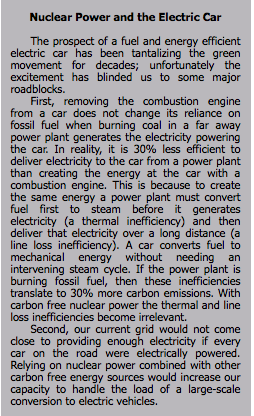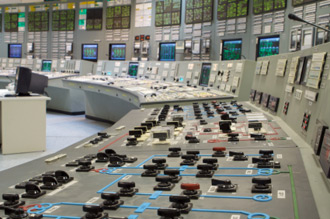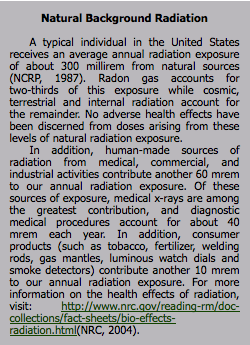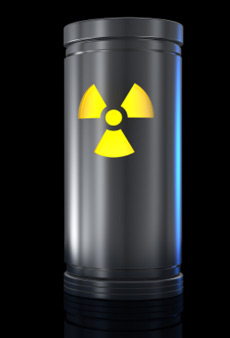Revisiting the Nuclear Option
The United States has no national energy policy, let alone a sustainable one. The absence of a coherent national energy policy affects each American every day, from subtle but serious health effects and climate change to major environmental and energy disasters. America has managed to grow its oil imports, eliminate local refinery development, defer long-term nuclear plant investments, marginalize electric car innovations and drive oil wells far offshore in deep water and away from safer areas. However, things are not as bad as they seem; North America is blessed with an abundance of natural resources and energy producing minerals (i.e., coal, crude and uranium) to power the U.S. into the quality of life to which it has grown accustom. The problem is how the country uses these resources to boil water.
Generating electricity on a large scale is as simple as boiling water: Boiling water makes steam that drives turbines, and turbines spin generators to create electric power. Boiling enough water at the right temperature is the challenge. How does the U.S. do this cleanly? Most of the time, the country boils water by burning fossil fuel; in fact, 70 percent of its electricity is produced this way. Sometimes the U.S. uses nuclear energy to boil water, but this accounts for only 20 percent of its electricity1. If Americans are serious about powering their lives with clean energy, this ratio needs to change. At the very least, reversing this 70/20 ratio must become a centerpiece to any serious national energy policy.2
Why Nuclear Power? Why Now?
 Greenhouse gas (GHG) emissions targets advocated around the world, and endorsed by President Obama, strive for an 80 percent reduction in carbon dioxide by 2050. Renewable energy, such as wind, solar and hydropower, will contribute, but in the U.S. this goal can only be achieved by replacing base load coal plants with nuclear power. The Department of Energy (DOE), Environmental Protection Agency (EPA) and the National Academy of Sciences (NAS) all agree that significant nuclear energy expansion, complemented with other clean energy sources, is necessary. The list of arguments for nuclear power is long. To name a few, it will create new demand for skilled workers, engineers and scientists, and inspire innovation and research to develop closed fuel recycling for the used fuel currently stored.
Greenhouse gas (GHG) emissions targets advocated around the world, and endorsed by President Obama, strive for an 80 percent reduction in carbon dioxide by 2050. Renewable energy, such as wind, solar and hydropower, will contribute, but in the U.S. this goal can only be achieved by replacing base load coal plants with nuclear power. The Department of Energy (DOE), Environmental Protection Agency (EPA) and the National Academy of Sciences (NAS) all agree that significant nuclear energy expansion, complemented with other clean energy sources, is necessary. The list of arguments for nuclear power is long. To name a few, it will create new demand for skilled workers, engineers and scientists, and inspire innovation and research to develop closed fuel recycling for the used fuel currently stored.
And, of course, nuclear power is a carbon-free operation. Unfortunately, these real benefits are often countered by both legitimate concerns (financial risk and waste) and popular misconceptions (high capital and operation costs, and exposure to dangerous radiation levels). Before the U.S. can shift its energy production from coal to nuclear, basic misunderstandings must be corrected, and several hurdles must be overcome. Four concerns are summarized below to begin addressing complex issues:
1. Uncertainty of Political Environment and Financial Risk
This is the issue that poses the biggest problem for nuclear power. As long as nuclear power does not have a stable role in U.S. energy policy, its future is dependent on the ever-changing political environment. This uncertainty translates into real financial and investment risk. Until politicians understand the importance of shifting America’s energy supply to 70 percent nuclear power, financing power plants will be increasingly difficult and expensive. Investing in nuclear power is an investment in our energy independence and our economy, and it should be encouraged. However, because it often takes longer than one political term to license and to construct a nuclear plant, there is always a risk that project approval can be reversed by the next administration. It is a difficult financial decision for an investor to make when a change in public sentiment, administration or policy can jeopardize nuclear power plant completion.
2. Construction Concerns and Operation Costs
Interestingly enough, American public opinion toward nuclear energy is not the product of political ideology or party politics. According to an MIT study 3 entitled “The Future of Nuclear Power,” U.S. public opposition is due primarily to public reaction to concrete technology and industry problems – notably, concerns over safety, toxic waste and poor economics. Not surprising, the study revealed a public that is skeptical about stalled technology. Advocate organizations claim nuclear costs are less per kWh (i.e., the amount of electricity 1,000 watt units generate in one hour) than coal, and opponents hold the opposite view. However, the MIT Study also concluded that the cost to produce electricity is about the same for coal as for nuclear options.

© iStockphoto.com/pozitivstudija
One important cost factor is the time and effort it takes to deliver a completed power plant. Nuclear plant construction takes five years while large coal plants take four years and natural gas takes two years. However, nuclear plants currently take three years for licensing and permitting with the Nuclear Regulatory Commission before construction could even begin, and this delay greatly inflates capital costs. Yet, despite increased capital costs, the MIT Study projected cost for nuclear, coal and gas (inclusive of $25/tCO2) as $.084/kWh, $.083/kwh and $.074/kWh, respectively. Consequently, the capital cost for nuclear is nearly twice that for fossil, but nuclear fuel cost is less than half. Additionally, these cost estimates do not account for social, health and environmental costs of burning fossil fuel. In reality, coal is associated with acid mine drainage, mining accidents, fly ash impacts, air quality degradation, greenhouse gas emissions and serious health consequences – all in an effort to boil water.
3. Health Concerns
 Despite common misconceptions, wide agreement exists that operation of nuclear plants is significantly less damaging to human health and the environment than power plants that burn fossil fuel.4 A 2009 report from Physicians for Social Responsibility, entitled “Coal’s Assault on Human Health,” examines coal’s contribution to major health effects and indicates that coal combustion emissions damage respiratory, cardiovascular and nervous systems, and contribute to four of the top five leading causes of death in the U.S.5
Despite common misconceptions, wide agreement exists that operation of nuclear plants is significantly less damaging to human health and the environment than power plants that burn fossil fuel.4 A 2009 report from Physicians for Social Responsibility, entitled “Coal’s Assault on Human Health,” examines coal’s contribution to major health effects and indicates that coal combustion emissions damage respiratory, cardiovascular and nervous systems, and contribute to four of the top five leading causes of death in the U.S.5
The Nuclear Regulatory Commission (NRC) regulates use of ionizing radiation and licenses new and existing nuclear power projects. Nearly a dozen new nuclear power plants are in the licensing review process today. On August 9, 2010, NRC announced release of the Levy County Florida nuclear unit Draft Environmental Impact Statement (DEIS) and the public meeting.6 The DEIS is the federal decision making document under National Environmental Policy Act (NEPA) that considers alternatives and consequences associated with federal action to approve or to deny application to construct and to operate a nuclear unit. Critical at this juncture is public involvement in determining the merit and inclusiveness of factors important to health, safety and the environment. The DEIS addresses radiological aspects of operation, and it has a detailed account of carbon emissions associated with project construction, operation and end-of-life demolition of the facility.
The NRC Staff concluded, among other important issues, that exposure to radioactive material releases projected from Levy is far less than radiation amounts occurring in nature. In fact, NRC regulates nuclear power reactor design and operations to be significantly less dangerous than exposure to radiation from natural conditions.7 EPA weighs in with additional standards for total cumulative whole body exposure limits of 25 mrem8 per year. Actual radioactive material releases from operating nuclear plants are orders of magnitude lower than regulatory limits. Additionally, the safety record of the U.S. commercial light water reactor nuclear program is unsurpassed by any other industry in America.9
4. Waste Management
The management and disposal of radioactive waste from the nuclear fuel cycle is one of the most difficult problems with nuclear power. Used fuel that can no longer support the required power level is called “spent” fuel and is stored at the power plant site. No current ultimate disposal or recycling plan exists to deal with this material. Spent nuclear fuel discharged from nuclear reactors will remain highly radioactive for many thousands of years. The primary goal of nuclear waste management is to ensure that radiation health risk exposure is reduced to an acceptably low level for as long as it poses a significant hazard. Currently, on-site storage is safe, effective and included in the architecture for new facilities while geologic repository and recycling options continue to be considered. Storage, however, is not the permanent solution.

© iStockphoto.com/ArtyFree
The French utility, EDF, produces nearly 80 percent of French generated electricity.10 The competitiveness of nuclear electricity and the large volume of base load electricity generated in France enable exports to other European countries, thus making EDF the world’s largest net electric power exporter. The 40-year experience of nuclear energy industrial operation has provided France with a demanding and high quality safety culture. France, with no uranium resources within its borders, has always been sensitive to nuclear waste management issues and aware of the risk of uranium resources exhaustion.
For many years, it has developed a recycling strategy for nuclear fuel that can no longer sustain nuclear reactions. Instead of considering it as waste to be disposed of, about 85 percent of EDF’s spent fuel is reprocessed today at Normandy’s La Hague plant. Ultimate waste is vitrified and stored awaiting final disposal. This process currently allows savings up to 25 percent of uranium resources and diminishes the volume and level of final waste radioactivity awaiting underground disposal by a factor of, respectively, 5 and 10. Additionally, final waste after recycling doesn’t raise proliferation concerns and is, therefore, relieved from safeguard obligations.
Now Is the Time

© iStockphoto.com/lagereek
Aged coal plants and retiring nuclear plants could possibly open the door toward the next generation of nuclear with passive emergency safeguard systems and latest fuel technology. Creating a national sustainable energy policy that leverages nuclear power with renewable energy will bolster our clean energy supply and revitalize our domestic energy producing industry. Tens-of-thousands of engineers, designers and skilled construction labor and operational staff would be employed, thus stimulating our economy and growth in higher education, as well as encouraging the return of manufacturing and vessel fabrication to the U.S. The benefits of reliable electric infrastructure include economic stability, production of manufactured goods, services, safety and quality of life. On the other hand, the status quo of burning fossil fuel to boil water is untenable because of high cost in terms of human health and associated environmental degradation.




























